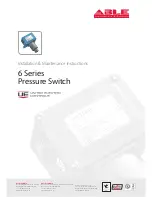
2-2
For the temperature and humidity requirements of different models, refer to section “
Cleanness Requirements
Dust is a potential hazard to the safe operation of the switch. Falling on the equipment, it may cause
electrostatic adsorption, and hence result in poor contact of the metal connectors or connection points.
This is more likely to happen when the indoor relative humidity is low; in this case, it may not only
shorten the device’s working life, but also incur communication failure. The requirements on dust
content and particle diameter in the equipment room are shown in the following table:
Table 2-1
Requirements on dust content in the equipment room
Physical active substance
Unit
Content
Dust particle
particle/m³
≤
3 × 10
4
(No visible dust on
desk in three days)
Note: Dust particle diameter
≥
5µm
Besides the requirements on dust, rigorous requirements are also set on the content of chloride, acid,
and sulfide in the air of the equipment room. These kinds of harmful gas will accelerate metal corrosion
and aging of certain parts. The equipment room should be protected from the intrusion of harmful gases
such as SO
2
, H
2
S, NH
3
and Cl
2
. The limits of these kinds of harmful gas are shown in the following table.
Table 2-2
Limits on harmful gas in the equipment room
Gas
Max content (mg/m³)
SO
2
0.2
H
2
S
0.006
NH
3
0.05
Cl
2
0.01
Anti-interference Requirements
A switch in use may be affected by the interference from outside the system by way of capacitance
coupling, inductance coupling, electromagnetic radiation, public impedance (including the grounding
system) coupling or conducting line (power line, signaling line, and transmission line). Therefore, you
should pay attention to the following:
z
If AC supply system is TN system, AC power socket should be a single-phase three-line power
socket with Protection Earth (PE) so that the filter circuit on the equipment can effectively filter out
the interference coming from the power supply system.
z
Keep the switch far away from high-power radio transmitters, radars, and high-frequency
heavy-current devices.
z
Adopt electromagnetic shielding measure if necessary. For example, you can adopt shielded
interface cable.
z
Wire interface cables indoors. Do not wire cables outdoors in case that over-voltage and
over-current damage the device.
















































